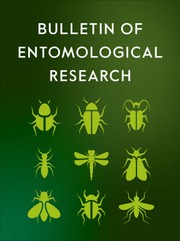No CrossRef data available.
Article contents
Characterisation and expression analysis of extracellular superoxide dismutases of Protohermes xanthodes navás (Megaloptera: Corydalidae) in response to sublethal chlorpyrifos exposure
Published online by Cambridge University Press: 01 July 2025
Abstract
The extracellular matrices, such as the haemolymph, in insects are at the centre of most physiological processes and are protected from oxidative stress by the extracellular antioxidant enzymes. In this study, we identified two secreted superoxide dismutase genes (PxSOD3 and PxSOD5) and investigated the oxidative stress induced by chlorpyrifos (CPF) in the aquatic insect Protohermes xanthodes (Megaloptera: Corydalidae). PxSOD3 and PxSOD5 contain the signal peptides at the N-terminus. Structure analysis revealed that PxSOD3 and PxSOD5 contain the conserved CuZn-SOD domain, which is mainly composed of β-sheets and has conserved copper and zinc binding sites. Both PxSOD3 and PxSOD5 are predicted to be soluble proteins located in the extracellular space. After exposure to different concentrations of sublethal CPF, MDA content in P. xanthodes larvae were increased in a dose-dependent manner; SOD and CAT activities were also higher in CPF-treated groups than that in the no CPF control, indicating that sublethal CPF induces oxidative stress in P. xanthodes larvae. Furthermore, PxSOD3 and PxSOD5 expression levels and haemolymph SOD activity in the larvae were downregulated by sublethal CPF at different concentrations. Our results suggest that the PxSOD3 and PxSOD5 are putative extracellular antioxidant enzymes that may play a role in maintaining the oxidative balance in the extracellular space. Sublethal CPF may induce oxidative stress in the extracellular space of P. xanthodes by reducing the gene expression and catalytic activity of extracellular SODs.
Information
- Type
- Research Paper
- Information
- Copyright
- © The Author(s), 2025. Published by Cambridge University Press.
Footnotes
These authors have contributed equally to this work and share first authorship


